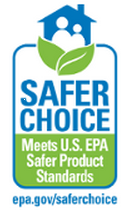US EPA Safer Choice Labeled Products
General purpose cleaners should be effective for most purposes and can remove 99% of germs.
Environmental & Health Information
The US EPA's Design for the Environment Program reviews all product ingredients, and assists formulators in choosing safer alternatives.
Criteria for US EPA Safer Choice Labeled Products
Info on this product category: General Purpose Cleaners
Why Go Green
Green cleaners on this site:
- Have safer ingredients. Cleaning products often contain a variety of hazardous ingredients, including quaternary ammonium compounds, alkylphenol ethoxylates, 2-butoxyethanol, glycol ethers, and ethanolamine. These pose health hazards to workers and building occupants, as well as environmental hazards downstream.
- Reduce waste, by emphasizing recycled and/or recyclable packaging.
- Are sold as concentrates whenever possible, which means that shipping weight is 1/64 – 1/256 that of ready to use products - dramatically reducing fuel requirements for shipping.
- Often use dilution systems to prevent exposure to concentrated products.
- Cost roughly equivalent to conventional products (see our report).
Criteria for General Purpose Cleaners
Criteria for Required products:
General purpose cleaners including peroxide-based and non-disinfecting cleaners:
1. Must not be in aerosol containers;
2. Concentrated cleaning chemicals must be in a spill-resistant package that prevents access to the undiluted chemical, and
3. Must be currently certified by at least one of the following:
- Cradle to Cradle Certified Gold level or higher, version 3.1 or later
- Green Seal
- Safer Choice
- UL ECOLOGO
Last updated
Reports
The Real Cost of Institutional Green Cleaning (2009) Report by SF Environment includes a cost survey of conventional vs. green cleaning products. Costs were roughly equivalent for most product categories. Costs of ready-to-use products averaged 15 times higher than concentrates; aerosols averaged 27 times higher.
Guide for City Staff
City Custodians:
- Are required to buy these cleaners (if needed):
- Dish soaps
- Floor finishes and strippers
- Furniture polish
- General purpose cleaners
- Glass cleaners
- Hand soaps
- Hand sanitizers
- Odor control
- Other cleaners, such as bathroom cleaners (non-disinfecting/non-sanitizing), including grout cleaners and toilet cleaners; carpet, rug and upholstery cleaners, including concentrated pre-spray, spot and stain removers, carpet shampoos and bonnet cleaners; cleaner-degreasers; enzymatic restroom cleaners; floor cleaners (including concentrated neutral floor cleaners, dust and damp mop cleaners); glass cleaners; multipurpose cleaners, including peroxide-based cleaners, deodorizers (odor control), toilet blocks and screens
- Toilet deodorizers
- Post the City department green cleaning checklist/poster.
- Post tips (for microfibers, disinfecting, dusting, polishing, floor care, kitchens, restrooms) and watch custodial green cleaning training videos in English, Cantonese, and Spanish made by SF Environment.
- Disinfectants are only important for surfaces like doorknobs.
- Switch to microfiber mops and cloths, which can prevent injuries because there's no need for heavy mop buckets.
- Install closed-loop dilution systems (if possible) to prevent employee exposure to hazardous concentrates.
Non-custodial City Staff:
- Try microfiber cloths, which can get rid of 99% of bacteria with plain water.
- Get discounted consumer general purpose cleaners, disinfectants, dish soaps, hand sanitizers.
- Make cleaners (air fresheners, oven cleaners, mold and mildew remover, wood furniture polish) with things like baking soda, castille soap, or lemon juice.
Recycling Instructions
It's illegal to trash cleaners (and other chemicals, electronics, lighting, metal, paints). So do one of the following:
- Use what you already have.
- Give them to someone who needs them.
- Legally and safely dispose them. Post this recycling poster above each trash bin. Then get a pick up.
Citywide Contract
Login to Staples. (Can't login? Email Kenneth.Easton@sfgov.org). Then click here to buy these green products.
Or see discounted prices in the most recent citywide contract award with Starline Supply for Envirox products.
Guide for Small Businesses & Homes
- Try microfiber mops and cloths, which can get rid of 99% of bacteria with plain water.
- Make your own cleaners from common materials like baking soda, castille soap, or lemon juice.
- See consumer products on GoodGuide.
- Use disinfectants sparingly. The most important surfaces are doorknobs.
- Choose ready-to-use, peroxide- or citric acid-based disinfectants. Avoid disinfectants that list hypochlorites or quaternary ammonium compounds as ingredients (e.g., ammonium chloride).
- Small businesses can save money by switching to industrial/institutional cleaners. Ready-to-use products are 15 times more expensive than concentrates.
- Custodial companies that are SF Green Businesses should watch custodial green cleaning training videos in English, Cantonese, and Spanish and consider posting Custodial Green Cleaning Tips (available in Spanish and Chinese) by SF Environment.
- Legally and safely dispose of cleaners (and other chemicals, electronics, lighting, metal, paints) in the San Francisco Bay Area or rest of the U.S.
Guide for Large Organizations
- Post the Custodial Green Cleaning Checklist/Poster and Tips (available in Spanish and Chinese).
- Watch custodial green cleaning training videos in English, Cantonese, and Spanish made by SF Environment.
- When creating contracts, paste specifications from the Criteria section above.
- Try microfiber mops and cloths, which can get rid of 99% of bacteria with plain water.
- Install closed-loop dilution systems to prevent employee exposure to hazardous concentrates.
- Legally and safely dispose of cleaners (and other chemicals, electronics, lighting, metal, paints) in the San Francisco Bay Area or rest of the U.S.





Write a Review